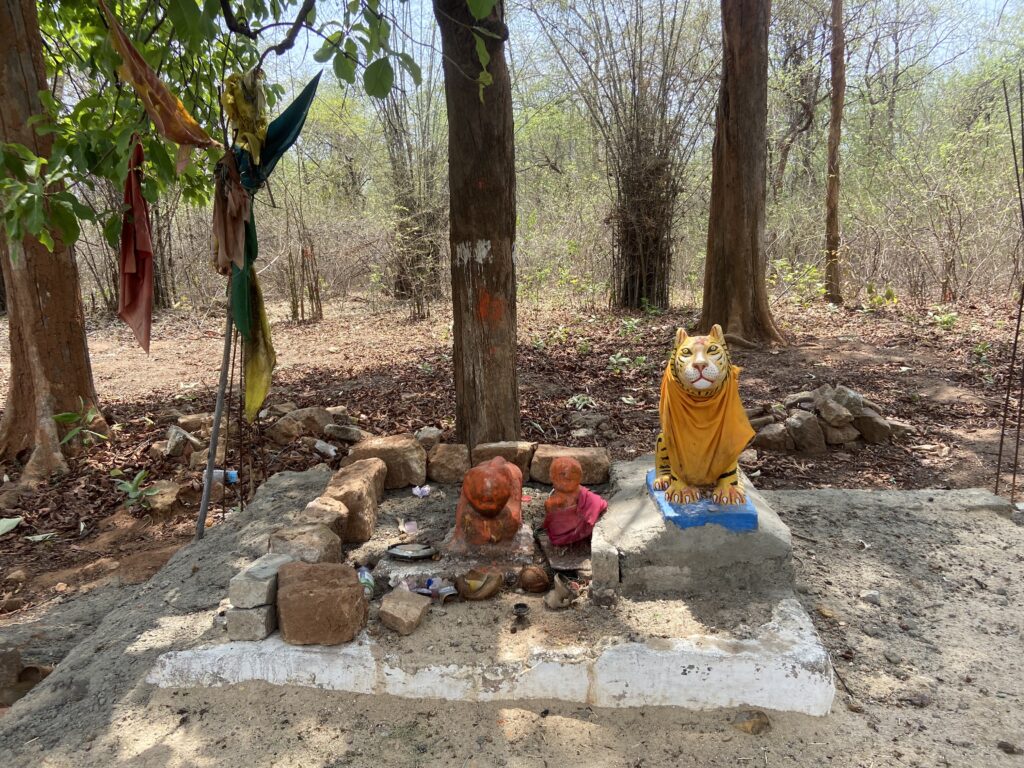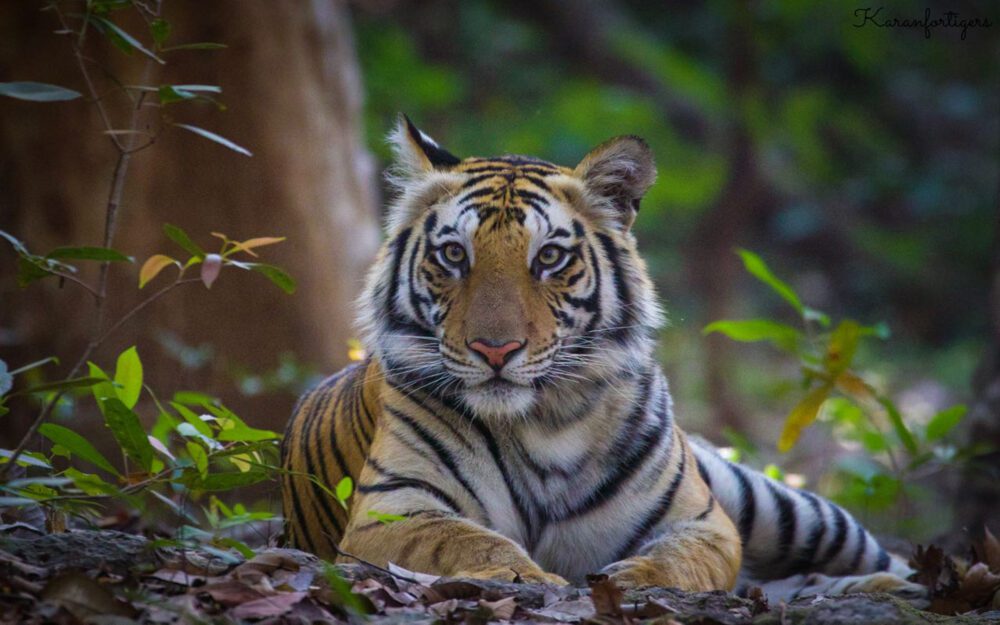Tiger worship in India is an age-old phenomenon. The indigenous communities living in the forests across the country share a mystical association with the big cats. Their reverence for tigers isn’t a mere mythological superstition or belief, but it comes from the innate co-dependence between the two species. The tribal folks depend on the forests for their livelihood—the natural habitat is life to these communities who cannot see themselves apart from the jungles.
People’s faith in tigers is so compelling that there are various names given to them by their devotees and there are many tiger temples across India. There are various philosophies and ideas behind worshipping tigers as a deity. Tiger is not just a wild animal with awe-inspiring appeal and beauty, but it has an enigmatic influence on people’s minds.
Why Do Tribal People Worship Tigers
Interestingly, different tribes from different regions in India worship tigers for their own unique reasons. The most common belief that tribal communities have about tigers is that they are their protectors. The Gond tribe of Madhya Pradesh, Garo tribe of Meghalaya, and Tulunadus of Dakshina Kannada district of Karnataka regard the tiger as their protector.
The tribes follow certain traditions and wear certain jewelry to profess their belief—Garos wear necklaces made with tiger claws entrenched in gold or silver for protection, and the Gonds keep the shoulder bone of the tiger with them believing it to bring strength. The Irula tribe of Tamil Nadu also believes that the tiger protects them from evil spirits. A pastoralist tribe in Maharashtra, known as Dhangars, venerates tigers as “Waghdev or Waghjai” with the notion that they protect their sheep.

Waghoba is a primeval tiger or leopard god, known to be the protector of the forest, worshipped by several tribal communities across India for ages. The Waghoba idols are hundreds of years old, and they are usually seen in small temples dedicated to tigers; however, it’s also seen in bigger temples dedicated to other gods.
If you are on a tiger safari in India, you will see some tiger temples on that safari and even guides worship them before going on a tiger safari.
The folks in Goa call their big cat deity “Waghro” and they also have a few shrines with extremely ancient idols. In a village called Vagragal in Goa, the tiger god is deified by the Velip community twice a year – two days after Ashadi Poornima and two days after Holi Poornima.
Also know about the: Evolution of Tigers

The tribes of the Sundarbans in West Bengal believe tigers to be the owners of the forest, and they are worshipped as “Bano bibi” and “Dakshin Ray” by both Hindus and Muslims. These deities are remembered while collecting honey in the forests, or by the woodcutters for safety against tiger attacks. The Santhals and the farmers of Odisha refer to tiger as “Bagheshwar” and “Banjara”.
The Mishmi tribe of northeastern India regards the tiger as their brother. The Baiga tribe of central India believes they are the posterity of the tiger. They also believe that if the tiger gods are happy, they bring rainfall to satisfy their lands, and if they are insulted in any manner, the farmers have to face drought. Tigers also signify fertility, which is why they are believed to bestow a good harvest.
Since tribal communities depend on forests for necessary resources, food, and firewood, they worship tigers and offer sacrificial offerings to them. They believe that tigers are appeased with their adoration and they do not enter their villages to harm them.
Even if a tiger attacks a villager, the devotees do not turn hostile toward their deity. In fact, the villagers build a temple close to the conflict point to possibly pacify the tiger.
Also Read: Interesting Facts About Tigers
Tigers and the Local Tribes of Forests Live in Harmony
Agriculture is the main occupation of the tribal folks living in the protected areas of the forests, the safety of their cultivation is vital to them. Apparently, the tigers protect their crops by keeping the herbivorous animals at bay. The dairy farmers in the forest vicinities also believe that tigers help in keeping milk thieves from intruding into their area.
The villagers are not afraid of the big cats, as they are like coheirs of the forests for ages. On the other hand, the tribal people help in tiger conservation.

“We worship tigers as Gods”—is what you hear from the tribes. The fact that tigers and the tribal communities have coexisted in harmony for ages adds a lot of weight to the theory that tiger numbers have increased significantly due to the presence of tribal folks in the core forest areas. However, there have been several conservation efforts by conservationists and the Indian Government as well, which have helped in growing tiger numbers in India.
When tribal folks worship different species, they do not primarily intend to conserve them. However, their devotion turns out to be beneficial for the whole ecosystem. The philosophy of nature worship in India is evident in our rich biodiversity—we have a huge human and cattle population, even though we barely have 2.5% of the world’s landmass and only 4% of rainwater resources. It is believed that people who are in awe of their flora and fauna safeguard them and do not harm them in any manner.
Also know about the: Tiger Sleeping Habits

The mutual relationship that the tribes share with the forests emerges out of their reverence for the cycles of nature and their sense of accountability for future generations. Their customs prescribe that they should never harm nature, waste anything or take more than they need. Hence, most of them work on the belief that you should return to nature what you receive from it. For instance, when they reap honey from high in the trees, Soligas, the tribe in southern Karnataka, take some for themselves and leave some on the ground just with respect to nature and forests.
Tribal communities have dwelled in the wild for generations, which is why they are the keepers of natural habitat and they know how to live with tigers. Hence, protecting the rights of tribal communities can be a way to conserve tigers.
The tribal folks know a great deal about wild animals and they also know how to protect themselves from tigers and leopards. The idea of tiger worship allows us to understand the human-animal relationship on a different level, which is rare in the arena of wildlife conservation.
Also Read: Top Places to see Tigers in India
Author: Renuka Walter
Visit our the Luxurious Lodges in Different location:
The Best Resort in Kanha National Park, Luxury Resort in Tadoba, Resort in Bandhavgarh National Park, Resort in Pench, Resorts in Satpura, and Panna to watch various fascinating species of the forests frolic in the untamed wild.
Get in touch with our trip curators at Pugdundee Safaris to book your next wildlife holiday.
As you plan your wildlife escape across central India, get in touch with our trip curators at Pugdundee Safaris.
Call us at: +91-9718637711, +91-8800637711 Email: [email protected]
We promise you a wildlife experience that is unique, authentic, and unforgettable.

